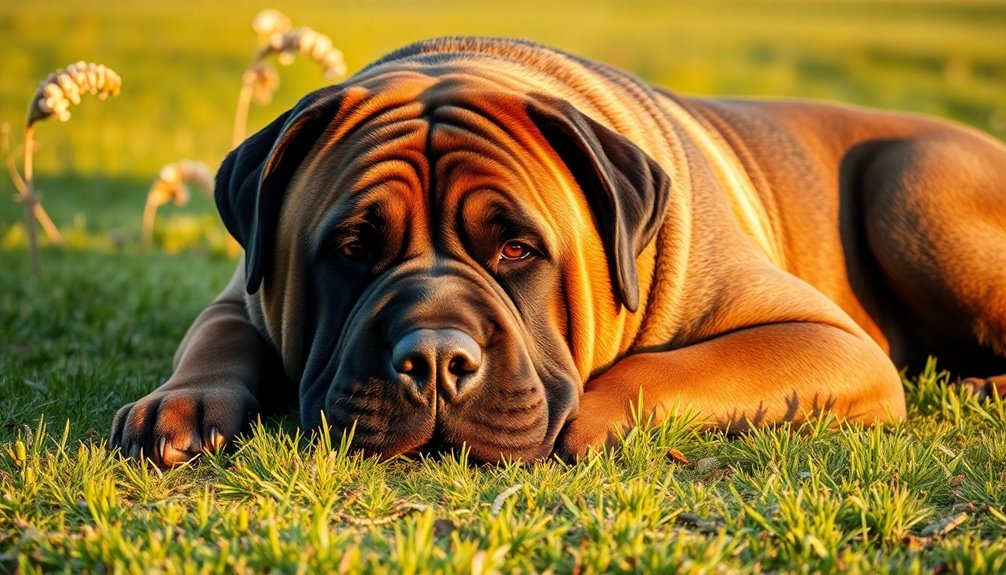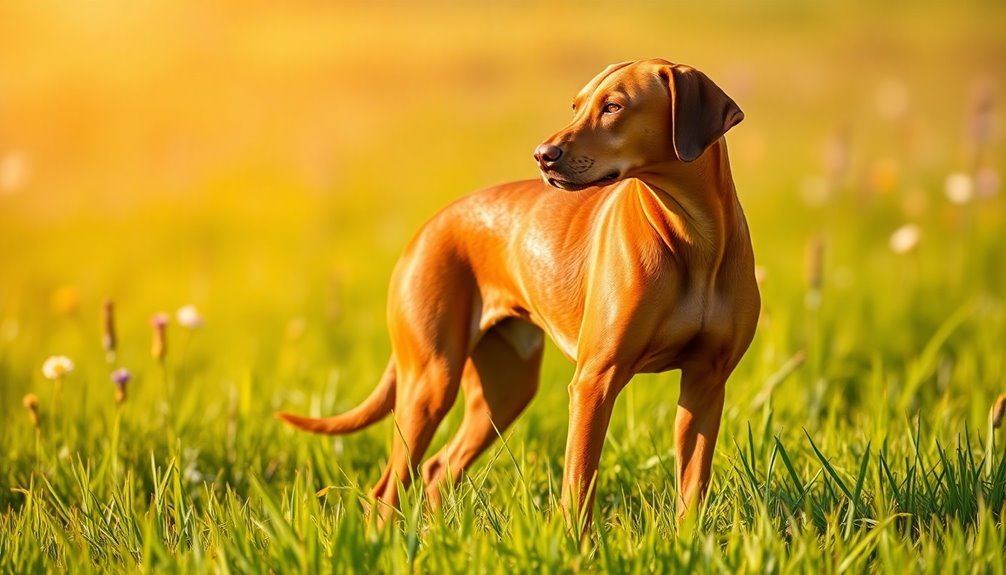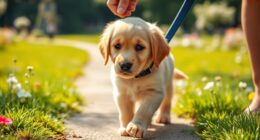Mastiffs, often called "gentle giants," stand as some of the largest yet most affectionate dogs you'll encounter. With males weighing up to 230 pounds, these loyal companions are known for their calm demeanor and strong bond with families. Their short, dense coats come in fawn, apricot, or brindle, adding to their majestic appearance. Though they require regular exercise and socialization, they're gentle with children and other pets. Their history dates back thousands of years, showcasing their strength in ancient civilizations. To truly appreciate the Mastiff's unique traits and care needs, there's much more to explore.
Key Takeaways
- Mastiffs are known as "gentle giants" due to their affectionate nature and calm demeanor, making them ideal family pets.
- They have a robust build, with males weighing up to 230 pounds and standing up to 30 inches tall.
- Early socialization and training are essential for their balanced temperament and behavior around children and other pets.
- Regular exercise of 30 minutes to 1 hour daily is needed to maintain their health and prevent obesity.
- Mastiffs are prone to specific health issues, requiring proper nutrition and regular veterinary check-ups for longevity.
Introduction
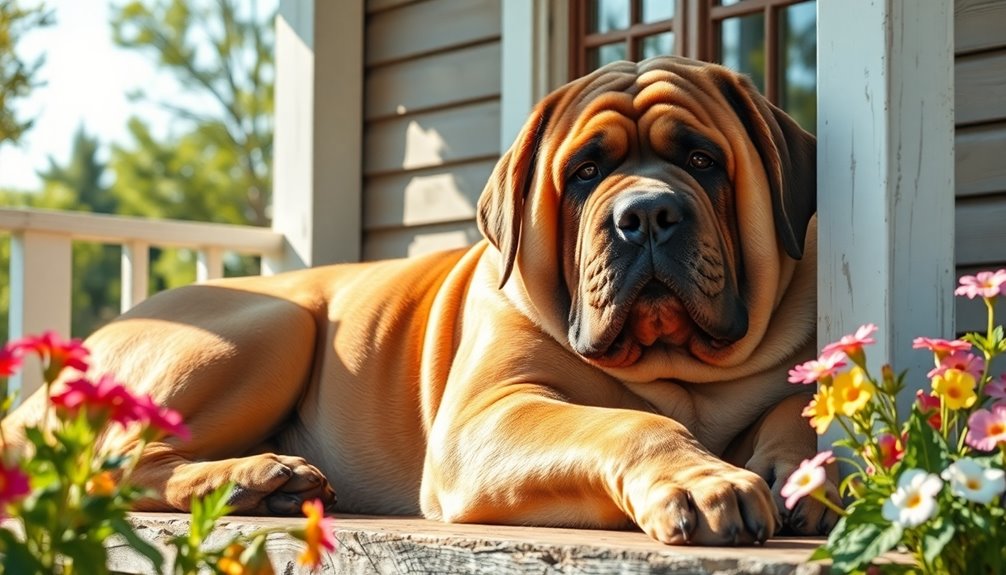
Mastiffs are often hailed as gentle giants, and for good reason. These impressive dogs can stand at least 30 inches tall for males and 27.5 inches for females, with weights ranging from 120 to 230 pounds. Their short, dense coats come in fawn, apricot, or brindle, typically featuring a striking black mask. With broad heads, drooping ears, and short muzzles, they've a distinctive appearance that commands attention.
Despite their massive size, Mastiffs are known for their affectionate and gentle temperament. They're loving toward family members and protective of their homes, making them excellent guard dogs. While they might be suspicious of strangers, they usually get along well with other household pets, including cats and dogs. Their guarding instinct contributes to their role as devoted protectors of their family and territory.
Mastiffs have a calm demeanor and aren't suited for high-energy activities; they enjoy leisurely walks of a mile or two each day. Their grooming needs are minimal, requiring weekly brushing and occasional cleaning of their ears and wrinkles.
With an average lifespan of 6 to 10 years, these loyal companions thrive on social interaction and attention, making them a wonderful addition to any family.
History and Origin
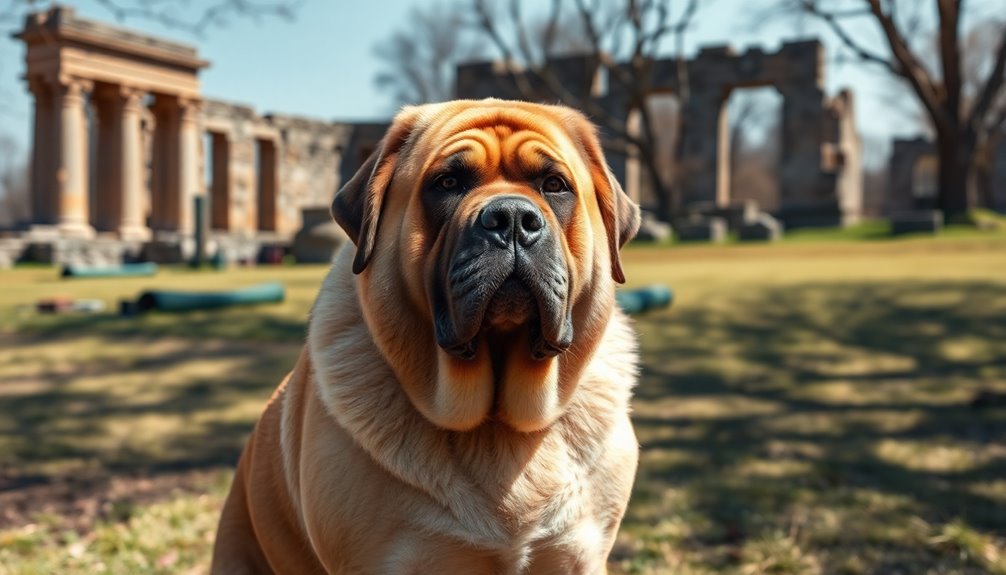
The Mastiff's roots trace back thousands of years to Central Asia, where its ancestors, the Molossers, first emerged. As they spread across Eurasia, they evolved into formidable guardians of estates and livestock, protecting their human companions from various threats. This breed's historical significance in guarding roles has shaped its gentle yet protective nature today. Over time, these dogs have been recognized for their strength and loyalty, especially noted during the Roman invasion when they impressed Julius Caesar with their size and capabilities.
Where and when the breed originated
Originating from ancient times, the Mastiff breed can trace its lineage back to the Molossers of Central Asia, which appeared thousands of years ago. Historical references to these impressive canines pop up in ancient Greece, Babylon, and even Classical Greek art. Evidence of Mastiff-like giant dogs dates back to around 2500 BC in the mountains of Asia, showing their long-standing presence. The Babylonian palace of Ashurbanipal features bas-reliefs depicting Mastiff-type dogs from the seventh century BC, further solidifying their ancient roots. The first written mention of Mastiffs comes from a Chinese document dating to 1121 BC.
The breed's journey to Europe began around 1500 BC when Phoenician traders introduced them to ancient Britain. By the time of the Roman invasion, Molossers had already made their home in the UK. Notably, the Romans utilized Mastiffs for guarding and in arenas, showcasing their strength and versatility.
Julius Caesar, impressed by these dogs, brought many back to Rome for arena battles. The term 'Mastiff' emerged in England during the 14th century, derived from the old French "mastin," which traces back to the Latin "mansuetus," meaning "to tame."
These early connections laid the foundation for the Mastiff's evolution and prominence in history.
Guarding Estates and Livestock
As their role evolved over centuries, Mastiffs became indispensable guardians of estates and livestock. In medieval Europe, these formidable dogs were tasked with protecting castles and lands from intruders and wild animals. British nobility often released them at night, relying on their imposing size and protective instincts to safeguard their properties. This practice was so valued that even King Canute's Forest Laws mandated their specific treatment to prevent them from chasing royal deer. Additionally, their loyalty and strength made them ideal guardians in various settings, further solidifying their status as protectors.
Mastiffs also played a crucial role in livestock protection, particularly against predators like wolves. They were bred to guard sheep flocks, forming strong bonds that enhanced their effectiveness. Regions like Spain recognized their prowess, where they became essential in safeguarding livestock from wolf attacks, reflecting the specialized role of Livestock Guardian Dogs that emerged around 4,000 years ago.
Historically, Mastiffs weren't just estate guardians; they served as war dogs and hunting companions, showcasing their bravery in battle and their skill in hunting large game.
Today, their guarding legacy continues, with modern Spanish Mastiffs protecting sheep in areas with growing wolf populations, proving that this gentle giant remains a steadfast protector both on estates and in the fields.
Physical Characteristics

When you think of a Mastiff, picture a massive dog with a short, broad muzzle and a sturdy build.
These gentle giants can weigh between 120 and 230 pounds, and their coats come in stunning colors like brindled fawn and apricot. Males can reach over 30 inches in height, making them one of the largest dog breeds.
With their impressive size and distinctive features, Mastiffs truly stand out in the dog world.
Size, weight, and coat details
The impressive size and robust build of the Mastiff make it one of the most recognizable breeds in the dog world. Males typically stand around 36 inches tall at the shoulder, while females range from 27 to 32 inches. Males can weigh between 160 to 220 pounds, and some can even exceed 300 pounds! In contrast, females usually weigh between 120 to 170 pounds.
You'll notice that Mastiffs undergo significant growth spurts in their first year. By 6 months, females may weigh between 70 to 95 pounds, while males can weigh 90 to 120 pounds. Growth spurts typically occur in the first year, leading to an increased appetite during this time.
As for their coat, it's short and dense, providing a striking appearance. The typical colors are fawn, apricot, or brindle, often accompanied by a distinctive black mask around the eyes and muzzle. Fawn colors can vary significantly, ranging from light "silver" to darker shades, while apricot and brindle add to their visual appeal.
Short, Broad Muzzle
Mastiffs are easily recognized by their short, broad muzzles, which contribute significantly to their imposing presence. This muzzle is about half the length of their large, broad skull, and its blunt end adds to the breed's dignified appearance. The characteristic shortness and width of the muzzle are essential features that enhance the Mastiff's grandeur.
Surrounding the muzzle, you'll notice a darkly colored mask that highlights their small, brown eyes. These eyes are set back into the skull, giving the breed a thoughtful expression. The face is distinctively wrinkled, and drooping jowls add to the overall gentle yet formidable look. The breed standard emphasizes the importance of these facial features, which aren't just for aesthetics but contribute to the Mastiff's calm demeanor. Interestingly, the Mastiff's history as war dogs showcases their strength and loyalty, further emphasizing their majestic presence.
Moreover, the small, v-shaped ears hang down, grazing the cheeks, further framing that broad muzzle. Overall, these physical traits work together to create a majestic yet approachable presence, making Mastiffs truly the gentle giants of the dog world.
Their short, broad muzzle isn't just about looks; it's a hallmark of their character and charm.
Temperament and Personality
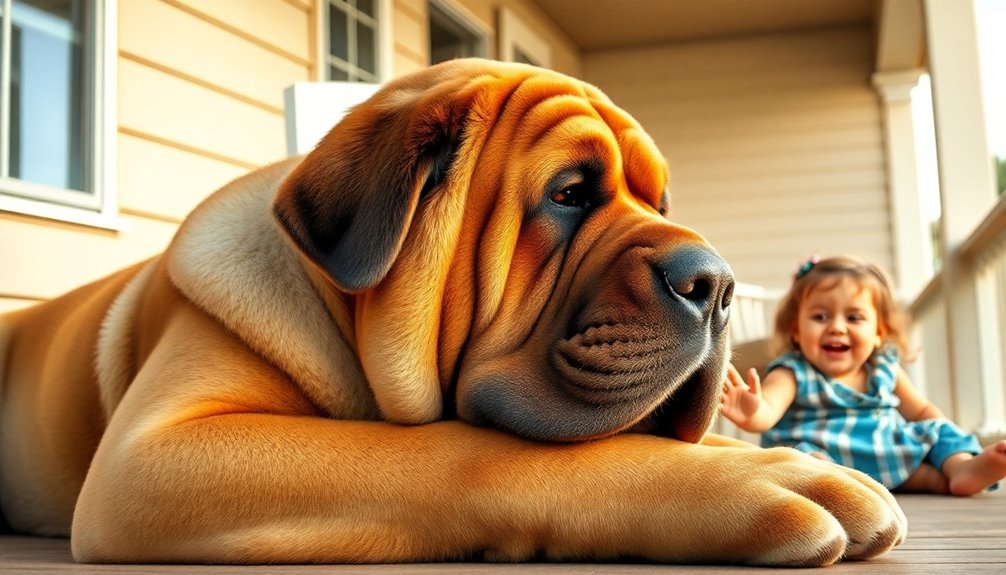
When you think of a Mastiff, imagine a gentle giant that's both protective and affectionate. These dogs thrive in family settings, easily bonding with children and other pets while offering a calm presence. Their unique temperament makes them a perfect fit for a variety of households, ensuring both safety and companionship. Additionally, their temperament and personality can be easily understood through their ability to adapt to various environments, reflecting their versatility as companions.
Gentle and Protective Demeanor
With their gentle nature and protective instincts, Mastiffs embody the perfect blend of affection and vigilance. These dogs are known for their affectionate and patient demeanor, earning a five out of five rating for affection from the American Kennel Club. You'll find that Mastiffs prefer gentle interactions, making them ideal companions in a calm home environment.
Despite their imposing size, they're loving family pets who thrive on close bonds with their families. Their protective instincts are equally impressive. Mastiffs are fiercely loyal and will defend their loved ones if necessary, using their size and strength. Their intense, loud bark serves as a warning, alerting you to potential threats. Additionally, their massive size alone can deter attackers before any confrontation occurs.
Historically, these dogs were trained to guard royalty, showcasing their innate ability to protect. Mastiffs are highly intelligent and controlled, which means they avoid mindless aggression. They respond well to positive reinforcement training and learn quickly.
While they can be wary of strangers, early socialization helps them develop a consistent temperament. With their even-keeled nature, Mastiffs will observe rather than bark excessively, providing you both comfort and security in your home.
Suitability for families, individuals, or other pets
Their gentle and protective nature makes Mastiffs not only great companions but also well-suited for various living situations, whether with families, individuals, or other pets.
If you have children, you'll find English Mastiffs to be kind and patient, although supervision is essential to prevent accidental injuries. They thrive in calm family environments, forming strong bonds with family members. A home without toddlers might be best, allowing them space to move comfortably. Additionally, dogs can have dietary sensitivities, so it's important to monitor any new foods introduced to their diet.
For individuals, Mastiffs can adapt well if you provide adequate attention and exercise. They're generally calm and don't need constant activity, making them suitable for those with busy schedules. Early training is crucial to prevent protective behaviors.
When it comes to other pets, Mastiffs can coexist peacefully with them, especially if introduced properly. Their loyalty and patience extend to all family members, furry or not. Additionally, their sociability varies, so it's important to assess their comfort level with other animals.
Regular interaction, positive reinforcement training, and engaging activities like walks or playtime strengthen the bond between you and your Mastiff.
Ultimately, whether you're a family or an individual, Mastiffs can be a loving and gentle addition to your home, fulfilling their emotional and physical needs.
Health and Lifespan
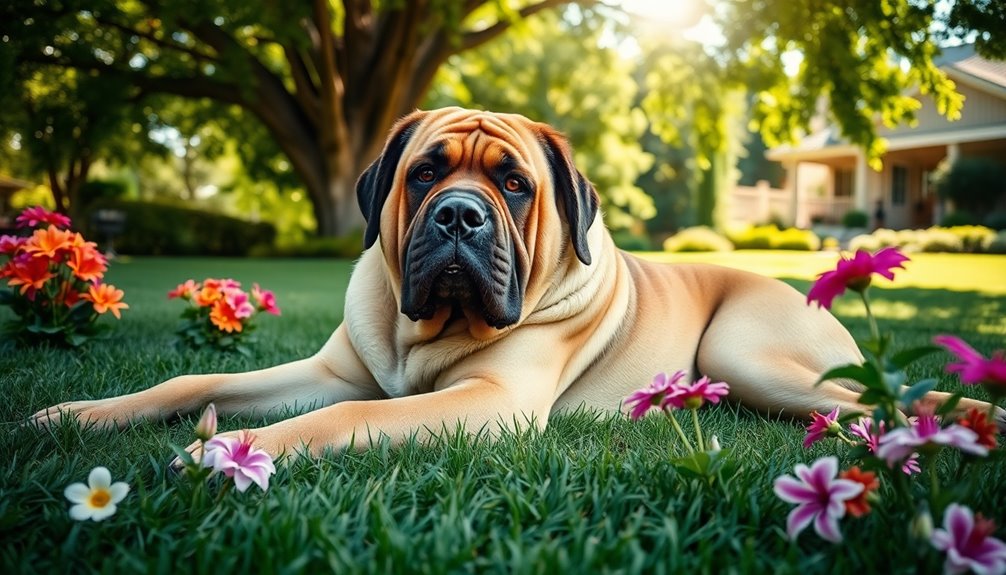
When you bring a Mastiff into your home, it's important to know their average lifespan ranges from 6 to 10 years. This breed is prone to certain health issues, such as heart disease and joint problems, which can impact their overall well-being. To ensure they live a long and healthy life, proper care and regular vet checkups are essential.
Typical lifespan of the breed
Mastiffs typically live between 6 to 10 years, a lifespan that reflects their status as one of the giant breeds in the dog world. The exact lifespan can vary among different sub-breeds; for instance, Bullmastiffs and Neapolitan Mastiffs often live 8 to 10 years. Additionally, larger breeds like Mastiffs are more prone to health issues that can impact their longevity, such as hip dysplasia and bloat.
When you compare them to other giant breeds like Great Danes and Saint Bernards, you'll notice a similar trend of shorter lifespans, generally ranging from 7 to 10 years.
Size plays a significant role in this shorter lifespan, as larger dogs tend to have reduced life expectancies compared to medium and small breeds.
During their lives, Mastiffs go through several stages: the puppy stage lasts up to 18 months, the young adult stage until about 3 to 4 years, the adult stage from 3 to 7 years, and finally, they enter the senior stage in their later years.
Proper nutrition, regular veterinary care, and a healthy lifestyle are crucial for maximizing your Mastiff's lifespan. With attentive care, you can help your gentle giant thrive during each of these stages.
Common health concerns or genetic predispositions
While Mastiffs are known for their gentle nature, they're also susceptible to several health concerns and genetic predispositions that can impact their quality of life. One major issue is degenerative myelopathy, an inherited neurological disorder that affects coordination.
Hip and elbow dysplasia can lead to arthritis and lameness, while thyroid problems, particularly hypothyroidism, may cause dry skin and behavioral changes. Cystinuria, a urinary tract issue, is more common in Mastiffs, and underbites can result in chronic pain and dental problems.
Heart conditions like dilated cardiomyopathy and subaortic stenosis are prevalent, emphasizing the need for annual heart health checks. Canine heart disease is a significant risk factor, making it crucial for Mastiff owners to be vigilant about their pet's heart health.
Cancer is another significant concern, with osteosarcoma and lymphosarcoma being particularly lethal. Regular vet check-ups and early detection play crucial roles in managing these risks. Additionally, eye diseases, obesity, bloat, and dental disease are common issues that can affect your Mastiff's overall health.
Being aware of these potential health issues allows you to take proactive steps to ensure your furry friend leads a healthy and happy life. Regular veterinary visits and attention to their diet and exercise are essential.
Tips for maintaining health and wellness
Regularly maintaining your Mastiff's health and wellness is essential for ensuring a long, happy life. Start by focusing on a well-balanced diet that meets their nutritional needs, prioritizing joint health and weight management.
Consult your vet to tailor a diet plan specific to your dog's age, weight, and activity level. Avoid obesity to reduce stress on joints, and consider high-quality food and supplements like antler chews for added nutrients. Mastiffs require a high-quality diet specifically formulated for large breeds to support their unique health needs.
Exercise is equally important. Provide regular, moderate activities such as daily walks and gentle play sessions, but steer clear of high-impact exercises that may worsen joint problems.
Monitor your Mastiff's growth carefully, as controlled exercise is crucial for puppies.
Don't forget routine veterinary care. Schedule regular check-ups to monitor health and catch issues early, including vaccinations and specific evaluations for heart health and joints.
Lastly, prioritize your Mastiff's mental well-being. Offer emotional support and engaging activities like puzzle toys and interactive games to prevent boredom and anxiety.
A stable, loving environment will help keep stress at bay, ensuring your gentle giant remains healthy and happy for years to come.
Care Requirements

Caring for a Mastiff involves a few key elements that keep them happy and healthy.
You'll need to focus on their moderate exercise needs, minimal brushing, and proper feeding to maintain their well-being. It is important to remember that their size and weight contribute to unique care requirements, making large breed care essential for their health.
Understanding these care requirements will help you provide the best life for your gentle giant.
Minimal Brushing Required
Brushing your Mastiff doesn't have to be a daunting task; in fact, it requires minimal effort to keep their coat healthy. You should brush your Mastiff at least once a week to manage shedding and distribute their natural skin oils. During shedding season, you might need to increase this frequency to a few times per week. Regular brushing not only helps keep their coat in good condition but also reduces loose hair and prevents matting.
For the best results, use a rubber curry brush or a short-bristled brush designed for their short, dense coat. A slicker brush can effectively remove loose hair and dirt without irritating their skin. When brushing, work in a downward direction from the neck to the tail to ensure an even grooming process. Regular baths help maintain a healthy coat and should be scheduled every 2-3 months.
Bathing your Mastiff every 2-3 months is also important, as it prevents stripping their coat of essential oils. Pairing regular baths with brushing can minimize shedding and maintain healthy skin.
Exercise requirements and energy levels
Although Mastiffs are known for their imposing size, their exercise requirements are quite manageable. You'll typically need to commit to 30 minutes to 1 hour of exercise each day. This can include leisurely walks, gentle play, and activities that stimulate their minds. Additionally, since they are known as "gentle giants(1)," their calm demeanor makes them excellent companions for various exercise routines. It's important to provide them with proper survival gear(2) that ensures their safety during outdoor activities.
Keep in mind that strenuous exercise could strain their joints, especially for puppies. Mastiffs have a medium energy level, which means they don't demand extensive physical activity like some smaller breeds. They're generally content with moderate exercise, making them adaptable to various living situations, including apartments, as long as they get enough companionship and activity.
For puppies, focus on short, controlled play sessions and gentle walks to protect their developing joints. Adults need regular moderate exercise to stay healthy and avoid weight gain, while seniors benefit from gentle activity to maintain mobility without overexertion. Be cautious about the heat; exercise during cooler parts of the day to prevent overheating. Always watch for signs of over-exercise, like excessive panting or reluctance to move.
Indoor activities like hide-and-seek or training new commands can also keep your Mastiff engaged when outdoor exercise isn't feasible.
Feeding tips and diet recommendations
Feeding your Mastiff requires attention to their unique nutritional needs to ensure they remain healthy and thrive. Start by offering high-quality protein sources like chicken, beef, fish, and eggs, essential for muscle maintenance. Including high-quality protein in their diet is crucial for maintaining their muscular mass. Additionally, ensure that your Mastiff's diet is aligned with their emotional alignment needs, as a well-fed dog can exhibit better behavior and mood stability.
Include healthy fats from fish oil and flaxseed to support energy and skin health. Carbohydrates, such as brown rice and vegetables, provide necessary energy and fiber for digestion.
Stick to a feeding schedule of two meals a day, with portion sizes adjusted based on your dog's age, weight, and activity level. Adult Mastiffs generally require 6 to 10 cups of dry food daily.
Puppies, on the other hand, need more calories and specific formulas for their rapid growth.
Monitor your Mastiff's intake and consult with your veterinarian to ensure proper nutrition. If your dog has grain allergies, consider a grain-free diet while ensuring all nutrients are met.
Use high-quality dog food with real meat as the first ingredient, avoiding fillers and toxic foods like chocolate and onions. Supporting joint health with glucosamine and omega-3s can also be beneficial.
Training and Socialization
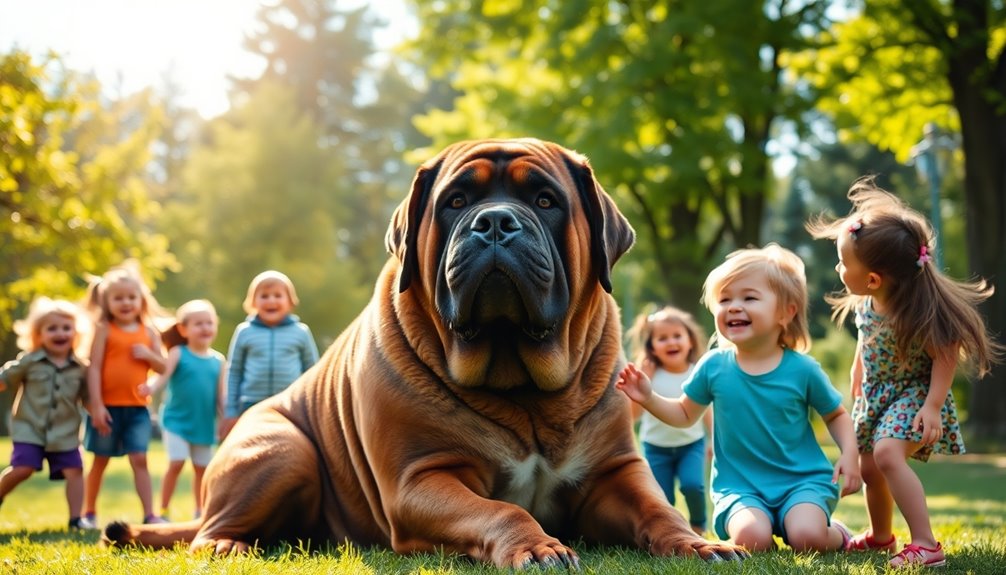
When it comes to training your Mastiff, you'll find they're moderately responsive to commands, so patience is key. Gradually exposing them to new environments helps build their confidence and reduces leash reactivity towards strangers. Starting training at an early age lays the foundation for good behavior and social skills.
Moderately Responsive to Commands
Mastiffs are moderately responsive to commands, which means you'll need to balance their intelligence and eagerness to please with their independent streak. Using positive reinforcement techniques like treats, praise, and rewards is crucial to motivate your Mastiff.
Keep training sessions short and engaging to prevent boredom, focusing on basic commands such as sit, stay, come, and heel. Being sensitive, Mastiffs don't respond well to harsh training or negative reinforcement, so patience and consistency are key.
Establish a strong foundation of obedience to ensure your dog listens reliably. Use specific praise words to reinforce good behavior and differentiate between work and play to maintain clear expectations. Additionally, these gentle giants can serve as effective guard dogs with proper training, showcasing their protective instincts.
Socialization is equally important, starting early to expose your Mastiff to diverse people and environments. Ensure these interactions are positive, using treats to reward good behavior.
Introduce your dog to other animals in controlled settings to promote healthy social skills. Lastly, remember that consistency is vital. Mastiffs can be sensitive to changes, so stick to routines.
With your commitment to positive training methods, you'll cultivate a well-behaved companion who thrives in various situations.
Gradual Exposure to New Environments
To build on the foundation of training, exposing your Mastiff to new environments gradually is key to developing their confidence and social skills.
Begin this process during the critical socialization window of 3-14 weeks. Start small with short trips to quiet, low-stress places, gradually introducing them to more diverse settings like parks and urban areas.
Use safe spaces, like the car or a covered crate, to let your puppy observe new surroundings without feeling overwhelmed. Bring along familiar items, such as their favorite toys or blankets, to provide comfort in these new experiences.
When meeting new people, control greetings by allowing your Mastiff to approach when they're ready, ensuring visitors ignore them initially. Gradual exposure to new environments allows for positive associations, reducing fear responses over time.
Familiarize your puppy with gentle handling, especially on their paws and ears, to prepare them for veterinary visits. Expose them gradually to household sounds, like vacuums and doorbells, and keep each experience positive by using treats and praise.
Remember to monitor your dog's comfort level—if they seem overwhelmed, it's okay to cut the outing short and try again later. This gradual exposure will help your Mastiff grow into a well-adjusted companion.
Leash Reactivity Towards Strangers
Leash reactivity towards strangers often manifests as negative behaviors when your Mastiff feels threatened or anxious. This isn't aggression; it's a reactive response that can occur even in well-behaved dogs off-leash. Common triggers include approaching people or dogs directly and tight leashes from owners. If your Mastiff has had bad encounters, like being attacked, it can increase their fear-based reactions.
To manage this, use reward-based training methods. Redirect their attention with commands like "heel" or "look" while maintaining a cheerful tone to associate strangers with positive experiences. Reward your dog with high-value treats when they stay calm around triggers.
Socialization is crucial. Introduce your Mastiff to a variety of people, including children and seniors, to lessen their anxiety. Arrange playdates with well-mannered dogs, ensuring every interaction is positive. Avoid overwhelming situations; focus on quality over quantity in socialization. Gradual exposure to triggers is vital for helping your Mastiff adjust to new experiences.
At home, address reactivity first, possibly desensitizing your dog with techniques like the Engage-Disengage Game. If necessary, greet guests outside to ease introductions.
With patience and consistent training, you can help your Mastiff feel more comfortable around strangers.
Ideal Living Environment

If you're considering bringing a Mastiff into your home, a spacious area with a secure yard is ideal for their comfort and well-being. These gentle giants thrive in moderate temperature ranges, so be mindful of their sensitivity to extreme heat. Additionally, they require ample space due to their size and are best suited for rural environments. With the right environment, your Mastiff will flourish and enjoy a happy, healthy life.
Spacious Home With Secure Yard
For Mastiffs, a spacious home with a secure yard is essential, allowing them the freedom to move around comfortably while also providing a safe environment.
These gentle giants require ample space to thrive, making country or rural settings ideal. A large, fenced yard is highly recommended to accommodate their size and activity needs. While apartment living can be manageable, it's not the best option due to space constraints.
A secure yard is crucial to prevent your Mastiff from escaping or encountering potential dangers. Ensure the fencing is tall and strong enough to contain their impressive size and strength. This secure area will also give them room to exercise and play safely. Regular maintenance of the yard is necessary to avoid injuries or escapes.
Mastiffs can adapt to various home environments, but they do best in homes with yards. They need sufficient indoor space to move comfortably, so consider dog-proofing your home to prevent damage. Additionally, their average lifespan of 6 to 12 years can be positively influenced by a secure and spacious living environment.
Be mindful of furniture and decor, as their size and strength can lead to messes. A spacious, secure environment is key to a happy, healthy Mastiff.
Prefers Moderate Temperature Ranges
Mastiffs thrive best in moderate temperature ranges, making it essential to maintain their comfort in varying climates. Ideally, keep indoor temperatures between 68-72°F (20-22°C) during winter months. These gentle giants prefer moderate climates and should avoid extreme temperatures. For outdoor activities, aim for temperatures between 60-69°F (16-20°C) to keep them happy and healthy.
While Mastiffs can handle cool weather, they struggle in extreme cold. Their short to medium-length coats provide only moderate insulation, leaving them vulnerable to hypothermia and frostbite in freezing temperatures. You'll notice signs of discomfort, like shivering or reluctance to go outside, when it's too cold. Cold weather** poses risks for their health, so it's crucial to monitor the temperature closely.
During winter, provide additional warmth and shelter to protect them. When it comes to outdoor activities in the cold, limit their time outside to prevent health issues. Consider protective clothing like coats or sweaters for added warmth.
After outdoor time, always ensure they've access to warm, sheltered areas. In warmer climates, make sure they've shade, water, and air conditioning to avoid overheating. With proper care, your Mastiff can enjoy life in various weather conditions.
Mastiffs Excel in Protection Roles
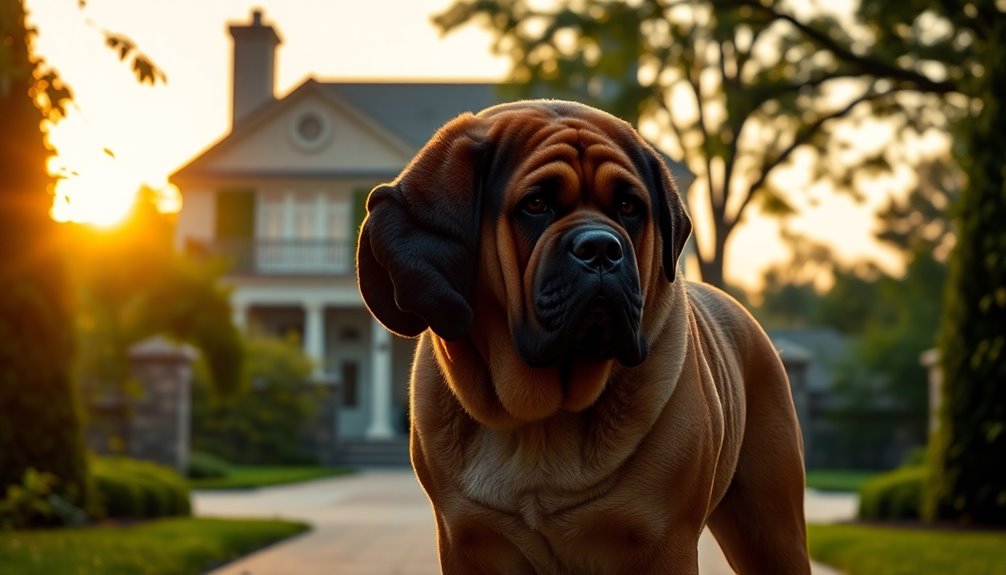
Mastiffs have a rich history as ancient war dogs, showcasing their protective instincts dating back thousands of years. You might recognize their powerful presence from popular culture, like the massive Mastiffs featured in "Game of Thrones," which highlight their role as formidable guardians. This lineage not only emphasizes their strength but also their unwavering loyalty to those they protect. Their innate capacity for guarding and protection makes them exceptional companions for families seeking both security and affection.
Ancient War Dog Lineage
Throughout history, the Mastiff has proven to be an exceptional protector, with a lineage that dates back thousands of years. Evidence suggests that Mastiff-like dogs roamed the mountains of Asia as early as 2500 BC.
In ancient Babylon, bas-reliefs show these formidable canines hunting lions, highlighting their strength and courage. Phoenician traders brought Mastiffs to Britain, where Romans later recognized their utility in hunting bears, boars, and lions, as well as guarding properties and temples.
In warfare, Mastiffs were invaluable. Ancient Celts took them into battle, while Hannibal famously transported trained Mastiffs across the Alps, influencing future giant breeds. These dogs even donned armor, charging enemy lines with their intimidating presence. Their historical significance as war dogs and protectors solidified their place in ancient societies.
Their role as sentinels continued during Roman rule, where they guarded prisoners and properties.
During medieval times, Mastiffs protected castles and estates, earning respect from nobility. Their involvement in combat and hunting showcased their versatility.
Despite being part of blood sports, their protective instincts remained a hallmark of their character. From the battlefields of ancient times to noble estates, Mastiffs have left an indelible mark on history as dedicated protectors.
Hollywood's 'Game of Thrones' Mastiffs
In the realm of fantasy television, the imposing presence of Mastiffs has captivated audiences, particularly in the iconic series "Game of Thrones."
These gentle giants not only enhance the dramatic portrayal of the story but also reflect their historical role as fierce protectors. Standing between 27.5 to 30+ inches at the shoulder and weighing between 120 to 230 pounds, their large, imposing build deters potential threats effectively. Mastiffs are known for their strong protective instincts, which make them exceptional guardians of their families.
Mastiffs are naturally protective and fiercely loyal to their families. They form strong bonds with their human companions, making them excellent guard dogs. Their fearless nature allows them to confront strangers and respond to threats without hesitation. Additionally, their calm demeanor makes them suitable for various living environments, allowing them to adapt well to family life.
While they possess an innate aggressive streak to defend loved ones, they're generally gentle and loving.
To manage their protective instincts, Mastiffs need extensive training and socialization. Early training with positive reinforcement helps them become well-mannered and confident pets.
Their loud, intense barks serve as a powerful deterrent, alerting you to potential dangers. With proper guidance, these gentle giants can channel their protective traits effectively, ensuring they're dependable guardians while remaining loving family members.
Space for a Gentle Giant?

If you're considering a Mastiff, you'll need to ensure you have the space to accommodate their size and energy. These gentle giants require ample room to move around comfortably and benefit from regular exercise to stay healthy. Committing to their needs means being an experienced handler who can provide the right environment for a Mastiff to thrive. Additionally, their calm temperament makes them suitable for various environments, as long as they have enough space to feel at ease.
Ideal for Experienced Handlers
Owning a Mastiff is like sharing your home with a gentle giant that needs space and experienced handling. These dogs aren't just big; they require a living environment that accommodates their size and temperament.
If you live in a small apartment, you must ensure there's enough room for them to move freely without feeling cramped. Regular access to open spaces is essential for their well-being, so living near a park is ideal. Mastiffs are one of the oldest dog breeds, making their history as impressive as their size.
As an experienced handler, you'll appreciate that Mastiffs thrive on routine and structure. Early socialization and positive reinforcement are key to shaping their behavior.
While they're generally calm and loyal, they can be sensitive to heat and require a cool environment, especially during warmer months. Being aware of potential health issues, such as hip dysplasia, is crucial, as is maintaining a balanced diet and regular vet check-ups.
You'll also need to commit to regular grooming and hygiene routines. If you embrace these responsibilities, living with a Mastiff can be incredibly rewarding.
Their gentle demeanor, paired with your expertise, can create a harmonious home for you both.
Commitment to Regular Exercise
Mastiffs thrive on regular exercise, making a commitment to their physical activity essential for their health and happiness. Aim for about 30 minutes to an hour of moderate exercise each day.
Low-impact activities are key to avoid stressing their joints, so consider leisurely walks or gentle play sessions. You can break up the exercise into shorter segments throughout the day.
Walking at a steady pace is perfect for your Mastiff. If you have a secure area, off-leash play is also great.
Incorporate short sessions of tug-of-war or mental activities like scent games and puzzle toys to keep them engaged. Regular exercise contributes positively to mental health and reduces anxiety, making it vital for your Mastiff's overall well-being. Swimming is another excellent low-impact option.
Frequently Asked Questions
What Is the Average Weight of a Mastiff Puppy?
The average weight of a Mastiff puppy varies significantly by age and breed.
At one month, male English Mastiffs typically weigh between 5 to 20 pounds, while females range from 5 to 15 pounds.
By six months, males can weigh 80 to 110 pounds and females 60 to 90 pounds.
Do Mastiffs Shed a Lot?
Yes, Mastiffs do shed, though it's manageable.
They've a double coat that sheds moderately year-round, with heavier shedding in spring and fall due to seasonal changes.
You'll notice more hair around the house during these times, especially in summer.
Regular brushing helps control the shedding, so make it a routine.
While they aren't hypoallergenic, keeping up with grooming can minimize the impact of their shedding on your home.
Can Mastiffs Live in Apartments?
Yes, Mastiffs can live in apartments, but it depends on a few factors.
You'll need ample space for them to move around comfortably. Daily exercise is crucial, so plan for at least 30 minutes of low-impact activity to keep them healthy.
Ensure the environment is cool, especially in warmer weather, and provide regular socialization opportunities.
With proper care and attention, your Mastiff can thrive in an apartment setting.
What Are Common Behavioral Issues in Mastiffs?
Common behavioral issues in Mastiffs include aggression due to lack of early training and socialization, leading to territorial tendencies.
They may also exhibit destructive behaviors from boredom or insufficient exercise.
Compulsive actions, like excessive licking, can arise without mental stimulation.
To address these issues, you should focus on consistent training, early socialization, and providing ample physical and mental engagement.
Using positive reinforcement techniques will help redirect unwanted behaviors effectively.
How Often Should I Bathe My Mastiff?
You don't need to bathe your Mastiff frequently; every 2-3 months is usually enough.
Only give them a bath if they get particularly dirty. Over-bathing can strip their fur of natural oils, leading to dry skin.
When you do bathe them, use a gentle, hypoallergenic shampoo and rinse thoroughly.
Regular brushing helps manage shedding and keeps their coat healthy, so make sure you brush at least once a week to maintain their coat.
Conclusion
In conclusion, the mastiff truly embodies the gentle giant spirit, balancing strength with a loving nature. By understanding their history, temperament, and needs, you can provide a nurturing environment for your mastiff. With proper training and socialization, these loyal companions can thrive in your home. Whether you need a protector or a cuddly friend, a mastiff can fit right into your life, proving that big hearts often come in big packages.

